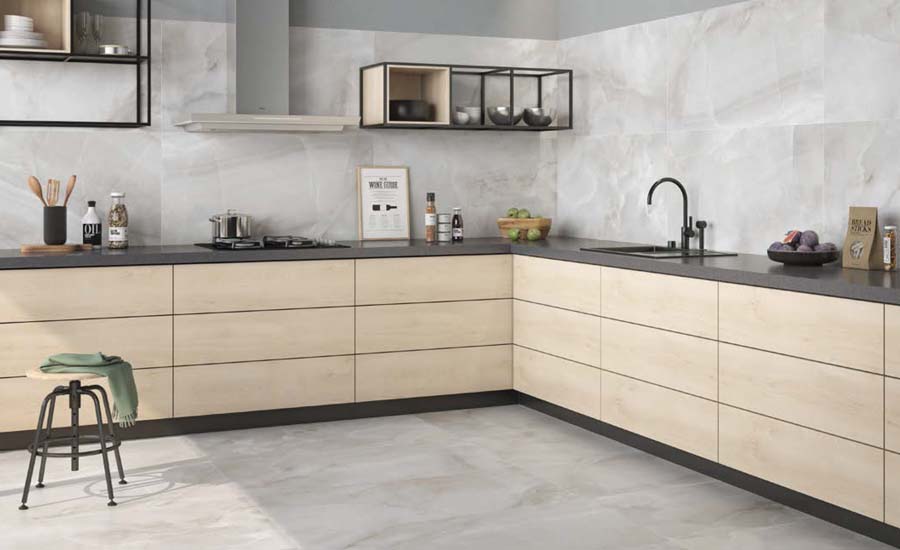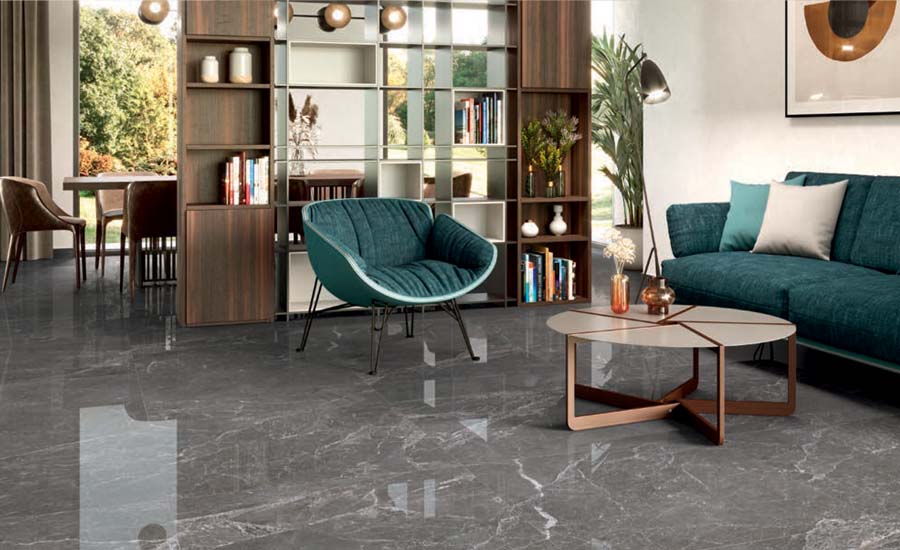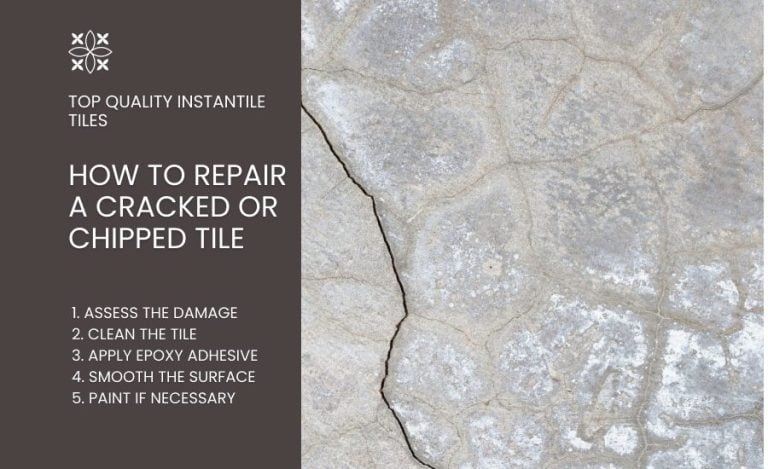Concrete vs. Stone Flooring: Key Takeaways
- Concrete and stone flooring differ in appearance, cost, and maintenance needs
- Concrete is easier to maintain and install, though it can crack and feel cold
- Stone adds natural beauty but often requires sealing and is prone to scratches and chipping
- Ceramic tiles serve as a smart alternative, mimicking the look of concrete or stone while being more affordable, low-maintenance, and quick to install
Whether it’s a stone pathway leading to a romantic garden or polished concrete floor in a new warehouse, natural stone and concrete are preferred flooring options for their durability and style. But how do they compare and how do you choose between the two?
In this guide, we’ll:
- Compare concrete vs. stone flooring
- List their pros and cons
- Present an innovative alternative that combines the best of both: Ceramista
Concrete vs. Stone Flooring: Expert Comparison
You can use both concrete and stone flooring in your home or commercial space. To make the most of their qualities, our experts at Ceramista have put together a detailed comparison guide.
Aesthetics
Concrete flooring gives a modern industrial feel wherever you decide to use it. It can be stained, polished, or stamped to mimic other materials, for example, stone and wood.
Stone’s unique veining, textures, and colors make your place exude nature, adding elegance to a room, restaurant or a shop.
Durability
Concrete flooring is built to last even under heavy traffic. However, if not properly installed or maintained, they may develop cracks over time, affecting their sleek appearance.
The durability of stone floors depends on the type of stone used. While harder stones like granite can easily resist wear, softer stones, such as marble and limestone, are prone to scratches and chipping.
Maintenance and Cleaning
Cleaning your concrete floor is simple and easy. All it needs is sweeping and damp mopping. To protect concrete from stains and moisture, make sure you seal your floors on a regular basis.
Stone requires a more careful approach. Use pH-neutral products to avoid damaging its surface. Additionally, seal porous types like limestone and travertine so moisture and stains do not damage their authentic and beautiful look.
Cost
Concrete is a more affordable flooring option, especially if you need to cover large areas. Note that if you prefer custom finishes like stamping or staining, this can add to the cost.
Stone floors are more expensive due to material extraction, transportation, and installation. Premium stones like marble and granite come at a significantly higher price.
Sustainability
Both concrete and stone provide sustainability challenges. Concrete has a high carbon footprint due to cement production while stone’s quarrying and transportation affects the environment.
However, both can be made more eco-friendly by using recycled materials, sourcing locally, and reducing the need for replacement with good care.
Understanding Concrete Flooring
Concrete flooring is a sturdy flooring option made from cement, water, and aggregates like sand, gravel, or crushed stone.
Concrete flooring comes in two main forms:
- Poured concrete, which is installed and finished on-site; it is typically used in large spaces such as warehouses, industrial facilities, shopping malls, or outdoor patios.
- Concrete tiles, which are pre-cast and installed like traditional tiles; this type is used for smaller areas and decorative applications like bathrooms, kitchens, courtyards, balconies, and staircases.
Highly durable and resistant to wear and tear, concrete can be polished, stained, or stamped to give your floor a different look in line with the design you like.
Stone Flooring Explained
Stone flooring is made from natural stones like marble, granite, limestone, and slate, each with distinct colors, textures, and characteristics.
Durable and attractive, stone flooring is a popular choice for both indoor and outdoor spaces.
To effectively resist moisture and stains, stone flooring requires regular sealing.
Concrete vs. Stone Flooring: Pros and Cons
Let’s look at their advantages and drawbacks to make the flooring puzzle clearer.
Concrete Flooring Pros
- Sturdy and long-lasting
- Can be customized with stamping or polishing
- More affordable than natural stone
- Easy to clean and maintain
- High thermal mass can improve energy efficiency
Concrete Flooring Cons
- Can crack over time
- Requires periodic sealing to prevent stains and moisture damage
- Hard surface can feel cold and uncomfortable underfoot
- Limited designs compared to stone
- High carbon footprint due to cement production
Stone Pros
- Natural look
- Unique textures and colors, with no two pieces being the same
- Exceptionally resilient, especially harder varieties like granite
- Adds value to a property due to its premium look
- Naturally cool, making it ideal for warm climates
Stone Cons
- Premium types can be quite expensive
- Porous stones require sealing and special cleaning products
- Some types are prone to scratches and chipping
- Heavier than concrete, requiring a strong subfloor
- Environmental impact due to quarrying and transportation
Ceramic Tiles: Enjoy the Look of Concrete and Stone Plus More Benefits
If you love how concrete or stone flooring look but want a more practical solution, there’s a perfect alternative to consider: ceramic tiles.
Why opt for tiles?
Thanks to cutting-edge printing tech, today’s ceramic tiles don’t just imitate; they master the look and feel of natural stone or polished concrete.
Resistant to scratches, stains, and moisture, they can be used both for indoor and outdoor settings, requiring little maintenance and cleaning efforts.
Modern types are produced responsibly using eco-friendly materials and production methods, making them a great choice for those who care about the environment.
For more insights into tiles and other flooring options, discover extensive guides by our experts at Ceramista:

Shop Concrete and Stone-Effect Tiles by Ceramista
Not all tiles are created equal, and Ceramista proves it.
Our advanced INSTANTILE interlocking system allows for installation up to nine times faster than conventional methods, with no adhesives, minimal tools, and no mess.
The result?
Faster turnaround, reduced labor costs, and a seamless, high-end finish.
Achieve the raw beauty of concrete or the timeless appeal of natural stone, reimagined with the efficiency and sustainability of Ceramista tiles.

Concrete, Stone and Tiles: FAQs
If you’re still unsure about your flooring, here is more information on concrete, stone and tiles.
Which is the most eco-friendly flooring option: stone, concrete, or tiles?
While both concrete and stone have eco-upgrades like recycled content and local sourcing, Ceramista’s ceramic tiles edge ahead with their sustainable manufacturing and minimal maintenance needs.
Which flooring option is best for my budget?
Standard concrete is the most budget-friendly option. The price of stone varies widely depending on the type. Tiles with a stone effect offer a cost-effective alternative to expensive natural stone.
Can I find tiles that look like stone?
Yes! At Ceramista, we offer modern ceramic tiles that replicate the textures and patterns of stone, wood, and even concrete, giving you the perfect look you desire.




